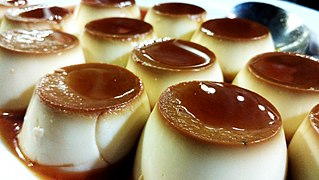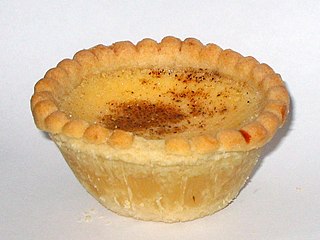
Dessert is a course that concludes a meal. The course consists of sweet foods, such as candy, and possibly a beverage such as dessert wine and liqueur. Some cultures sweeten foods that are more commonly savory to create desserts. In some parts of the world there is no tradition of a dessert course to conclude a meal.

Spanish cuisine consists of the traditions and practices of Spanish cooking. It features considerable regional diversity, with important differences between the traditions of each part of Spain.

Crème caramel, flan, caramel pudding, condensed milk pudding or caramel custard is a custard dessert with a layer of clear caramel sauce.

Cheesecake is a sweet dessert made with a soft fresh cheese, eggs, and sugar. It may have a crust or base made from crushed cookies, graham crackers, pastry, or sometimes sponge cake. Cheesecake may be baked or unbaked, and is usually refrigerated.

Rice pudding is a dish made from rice mixed with water or milk and other ingredients such as cinnamon, vanilla, and raisins.

Iraqi cuisine is a Middle Eastern cuisine that has its origins in the ancient Near East culture of the fertile crescent. Tablets found in ancient ruins in Iraq show recipes prepared in the temples during religious festivals—the first cookbooks in the world. Ancient Mesopotamia was home to a sophisticated and highly advanced civilization, in all fields of knowledge, including the culinary arts.

Melktert is a South African dessert originally created by the Dutch settlers in the "Cape" consisting of a sweet pastry crust containing a custard filling made from milk, flour, sugar and eggs. The ratio of milk to eggs is higher than in a traditional Portuguese custard tart or Chinese egg tart, resulting in a lighter texture and a stronger milk flavour.

Cypriot cuisine is the cuisine of the island of Cyprus, shared by both Greek Cypriots and Turkish Cypriots.

Cantabrian cuisine is the cuisine from Cantabria, an autonomous community in northern Spain. It includes seafood from the Cantabrian Sea, salmon and trout from the upper basins of the rivers, vegetables and dairy products from the valleys, and veal and game from the Cantabrian mountains.

Custard tarts or flan pâtissier/parisien are a baked pastry consisting of an outer pastry crust filled with egg custard.

Dessert bars, or simply bars or squares, are a type of American "bar cookie" that has the texture of a firm cake or softer than usual cookie. They are prepared in a pan and then baked in the oven. They are cut into squares or rectangles. They are staples of bake sales and are often made for birthdays. They are especially popular during the holidays, but many people eat them all year. Many coffee shops and bakeries also offer the treats. Popular flavors include peanut butter bars, lemon bars, chocolate coconut bars, pineapple bars, apple bars, almond bars, toffee bars, chocolate cheesecake bars and the "famous" seven-layer bar. In addition to sugar, eggs, butter, flour and milk, common ingredients are chocolate chips, nuts, raspberry jam, coconut, cocoa powder, graham cracker, pudding, mini-marshmallows and peanut butter. More exotic bars can be made with ingredients including sour cream, rhubarb, pretzels, candies, vanilla, raisins, and pumpkin. The Nanaimo bar is a bar dessert that requires no baking and is named after the city of Nanaimo, British Columbia.

Mizrahi Jewish cuisine is an assortment of cooking traditions that developed among the Jews of the Middle East, North Africa, Asia, and Arab countries. Mizrahi Jews have also been known as Oriental Jews.

Sponge cake is a light cake made with egg whites, flour and sugar, sometimes leavened with baking powder. Some sponge cakes do not contain egg yolks, like angel food cake, but most of them do. Sponge cakes, leavened with beaten eggs, originated during the Renaissance, possibly in Spain. The sponge cake is thought to be one of the first non-yeasted cakes, and the earliest attested sponge cake recipe in English is found in a book by the English poet Gervase Markham, The English Huswife, Containing the Inward and Outward Virtues Which Ought to Be in a Complete Woman (1615). Still, the cake was much more like a cracker: thin and crispy. Sponge cakes became the cake recognised today when bakers started using beaten eggs as a rising agent in the mid-18th century. The Victorian creation of baking powder by English food manufacturer Alfred Bird in 1843 allowed the addition of butter to the traditional sponge recipe, resulting in the creation of the Victoria sponge. Cakes are available in many flavours and have many recipes as well. Sponge cakes have become snack cakes via the Twinkie.
Romani cuisine is the cuisine of the ethnic Romani people. There is no specific "Roma cuisine"; it varies and is culinarily influenced by the respective countries where they have often lived for centuries. Hence, it is influenced by European cuisine even though the Romani people originated from the Indian subcontinent. Their cookery incorporates Indian and South Asian influences, but is also very similar to Hungarian cuisine. The many cultures that the Roma contacted are reflected in their cooking, resulting in many different cuisines. Some of these cultures are Middle European, Germany, Great Britain, and Spain. The cuisine of Muslim Romani people is also influenced by Balkan cuisine and Turkish cuisine. Many Roma do not eat food prepared by a non-Roma.

Sholezard is an Iranian traditional saffron rice pudding dessert.

Blueberry sauce is a sauce prepared using blueberries as a primary ingredient. It is typically prepared as a reduction, and can be used as a dessert sauce or savory sauce depending on the preparation. It can also be used in the preparation of the blueberry Martini.
Quesadilla salvadoreña is a pan dulce, similar to a pound cake, made with rice flour and queso duro blanco and topped with sesame seeds, that is popular in El Salvador. Queso duro blanco is near impossible to obtain outside of El Salvador, so the substitute for it is usually either cotija, Parmesan or feta cheese. It is commonly served with coffee as part of breakfast or as a snack. It is traditionally baked on Sunday mornings.















